Harnessing the Sun: A Beginner’s Guide to Off-Grid Solar Systems
Curious to learn how off-grid solar systems work and how to design your own system?
A Beginner’s Guide to Off-Grid Solar Systems
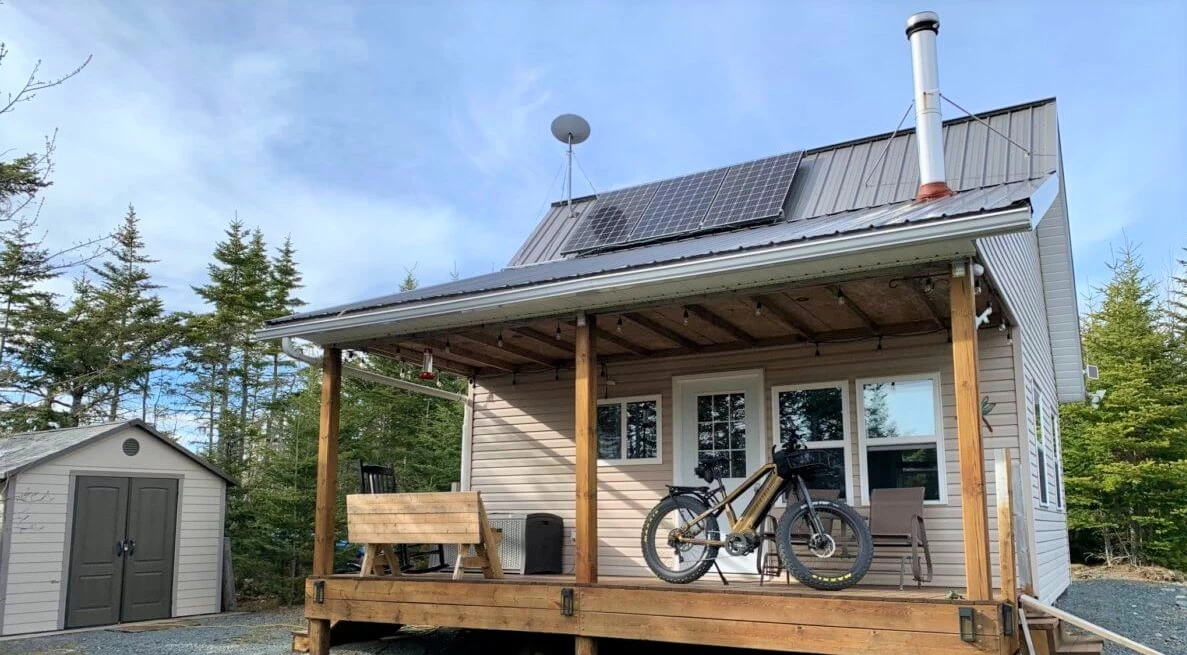
Welcome to our most enlightening blog post yet “A Beginner’s Guide to Off-Grid Solar Systems”. Today we’ll embark on a rather illuminating journey into the realm of sustainable living by harnessing the power of the sun and the basics of off-grid solar power. We’ll cover five main categories in this introduction to off-grid solar systems.
- Understanding Off-Grid Solar Systems
- Advantages of Off-Grid Solar Systems
- Designing Your Off-Grid System
- Installation and Maintenance
- Off-Grid Living Considerations
Along the way, we’ll also include the complete breakdown of the solar system we use here at the off grid cabin and the links for specific component details.
NOTE: This serves as a reference solely. To access the technical details of a specific solar system, refer to the manufactures company/manual for choosing the proper solar system and battery for your off-grid situation. The installation of solar and battery storage systems necessitates the expertise of a licensed electrical professional with experience. These systems harness and store substantial energy quantities, carrying the potential for damage, fire, or severe injury if the installation fails to adhere to pertinent regulations, standards, and guidelines.
In a world increasingly defined by its voracious energy demands, a growing number of individuals are embracing a life off grid by unplugging from city utilities. More and more people are embracing a life of self-generated power. While most , if not all our community, are off grid and/or homesteaders there is a growing population that are still grid tied but 100% solar. This vision was a distant dream for most just a few years ago. Fast Forward to today and there are millions of homes and businesses generating the majority, if not all, of their energy requirements through solar. Let’s get started…
Want Us To Show You Our Complete Cabin Build Instructions & Costs?
You can grab our complete floor plans, materials list, cost list and a step-by-step build list as a THANK YOU for just or dropping by and checking us out!
1 Understanding Off-Grid Solar Systems
Off-grid solar systems, also known as standalone solar systems, are self-contained energy solutions designed to provide electricity in areas without access to centralized power grids or for folks like us who choose to live off the grid. Unlike grid-tied systems that rely on utility companies, off-grid systems generate electricity from sunlight, store it in batteries, and convert it into usable power for household needs.
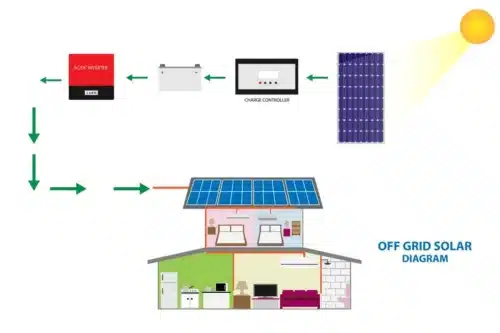
The primary purpose of off-grid solar systems is to enable energy independence and still enjoy all the technologies of today. By harnessing the abundant energy of the sun, individuals can reduce or eliminate their dependence on fossil fuels and completely eliminate a monthly utility bill. These systems empower not only individual homeowners but remote communities and perhaps in the future entire villages, towns, and cites.
Our solar system was purchased from a company here in Canada that specializes in complete off grid solar systems.
We have decided to partner a very trustworthy and knowledgeable company here in Canada called Solar Power Store.
They have a complete range of Off Grid Solar Energy Kits
We’ve broken down each component below and included additional links which cover the fine details and specs regarding that piece of the system. We will also be posting future blog posts covering the exact details of how each individual component works, the role they play in the solar system and where you can find these components yourself. We’ve taken all the work out of selecting a solar system that’s right for you
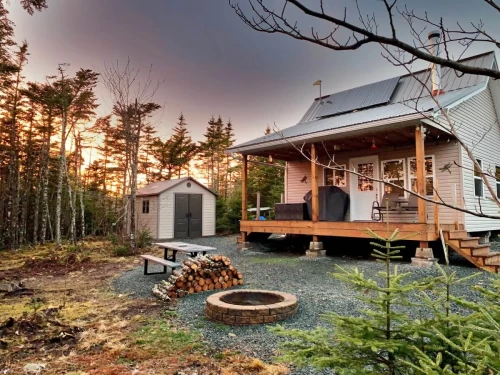
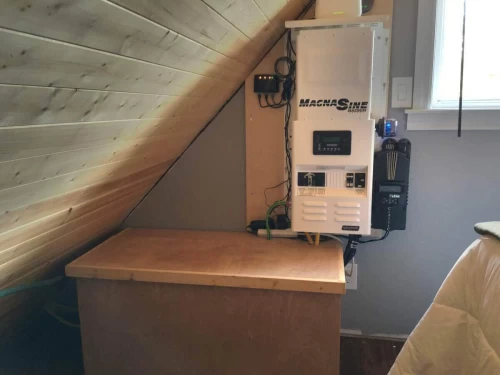
The Building Blocks of Off-Grid Solar Systems
Off-grid solar systems consist of several crucial components working in harmony to generate, store, and deliver electricity. Here’s a breakdown of the main element.
Solar Panels
Photovoltaic solar panels capture sunlight and convert it into direct current (DC) electricity. These panels are typically mounted on rooftops or open areas to maximize sun exposure. We’ll dive deeper in additional posts of how to choose the proper size panels, orientation, and angle for optimal energy absorption based on your geographic location and seasonal changes. While there are several types of solar panels available the majority of off grid systems use either…
Monocrystalline (mono) panels: These panels offer the best efficiency and generate more power than other types. Because of their high performance, you’ll need fewer panels to power your home. Monocrystalline panels are more expensive but last 25 years or longer.
Polycrystalline (poly) panels: These panels are less expensive than mono options but offer less power and efficiency. They last up to 20 years with regular maintenance. Because of their lower performance, you’ll need more panels to meet your energy needs. Consider your available roof space, power needs, and budget when comparing mono to poly panels.
We currently have three 280W Monocrystalline solar panels for our setup. On a clear sunny day this relatively small setup can produce up to 5Kw of power. More than enough to fully charge the battery bank, run our full sized fridge, Keurig, Starlink internet, Shurflo water pump, LED projector, all the lights (ten LED ceiling pot lights) and even partially charge our Tesla Model Y.
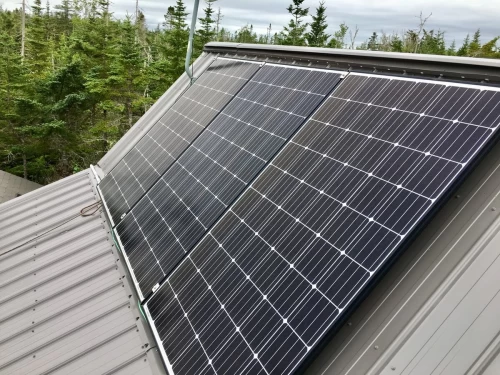
Charge Controllers
Charge controllers regulate the flow of electricity from the solar panels to the batteries. They prevent overcharging, which can damage the batteries, and ensure efficient energy storage. Just like there are different types of solar panels there are also different charge controllers.
PWM (Pulse Width Modulation) Charge Controllers: are one of the earlier types and are suitable for basic off-grid systems. They regulate the charging process by pulsing the battery voltage, maintaining a relatively constant charging voltage. As the battery voltage increases, the controller reduces the pulse width to prevent overcharging.
MPPT (Maximum Power Point Tracking) Charge Controllers: are advanced and highly efficient, making them a popular choice for larger and more complex off-grid systems. They use advanced algorithms to track the maximum power point of the solar panels, allowing them to harvest more energy from varying solar conditions. MPPT controllers can convert excess voltage into additional current, maximizing the energy transferred to the batteries.
PWM with MPPT Functionality: some controllers combine PWM regulation with basic MPPT functionality. While not as efficient as dedicated MPPT controllers, they offer a balance between cost and performance for mid-range off-grid systems.
Diversion Load Charge Controllers: these are used in systems with excess energy that can’t be stored in the batteries. They divert surplus energy to other loads, such as water heaters or dump loads, preventing overcharging of batteries.
Lighting Charge Controllers: are designed specifically for solar lighting systems, these controllers regulate the charge and discharge of batteries powering outdoor lights. They often include features like dusk-to-dawn settings and timer controls.
Our system uses the very popular Midnite Solar Classic 150V MPPT Charge Controller. This unit is capable of not only controlling input power from solar panels but also hydro and wind. With the Midnite Classic 150 we are also able to monitor our solar system remotely over the internet using either a computer or smartphone. That’s the black component on the bottom right side of our setup below.

Batteries
Energy captured by the solar panels is stored in batteries for use when the sun isn’t shining. Deep-cycle batteries, designed to discharge and recharge repeatedly, are commonly used in off-grid systems. The two main types of batteries used in off grid systems are lead-acid and lithium-ion.
Lead-Acid Batteries
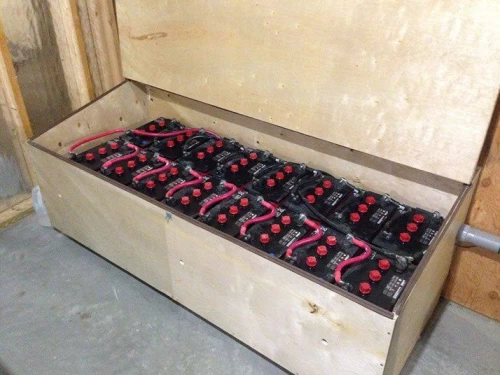
The Flooded Lead-Acid: These are traditional, affordable batteries with a liquid electrolyte. They require regular maintenance and proper ventilation due to off-gassing.
Sealed Lead-Acid (AGM and Gel): These maintenance-free batteries use absorbed glass mat (AGM) or gel electrolytes. They are more expensive but offer better safety and can be placed indoors.
Lithium-Ion Batteries
Lithium Iron Phosphate (LiFePO4): Known for their high cycle life, durability, and safety. They have a longer lifespan compared to lead-acid batteries and require minimal maintenance.
Lithium NMC (Nickel Manganese Cobalt): Commonly used in electric vehicles, these batteries offer high energy density and longer cycle life. They’re suitable for energy-intensive applications.
Our solar setup utilizes four 6 volt Matrix, 6V, AGM “L16” Battery 415Ah @ 20hr. They each weigh a hefty 123 pounds! Because they are AGM (absorbent glass mat) they do not off-gas and can be kept in a storage box built by my dad inside in the loft. Here they are kept at a constant temperature all year long elongating their lifespan. Our plan, once these batteries have run their lifespan (usually 10-12 years) is to switch to a much smaller, lighter lithium ion single battery pack. The main advantage of a lithium ion battery beside size and weight is that they can be drawn down to much lower voltages and therefore use much more of their power storage capacity.
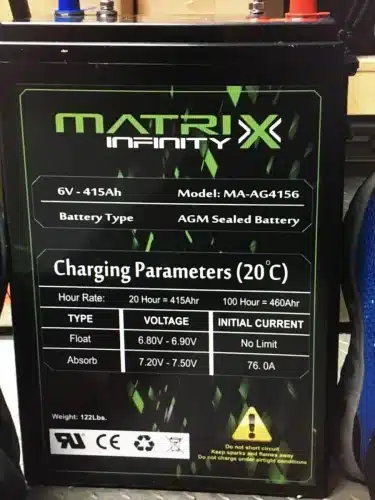
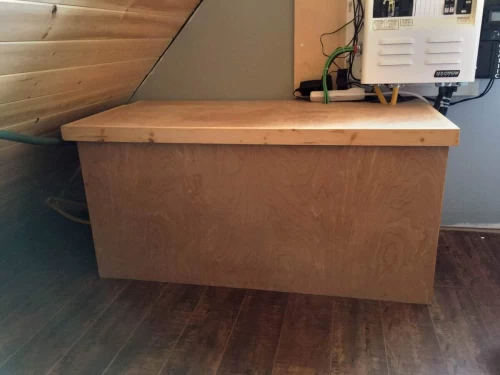
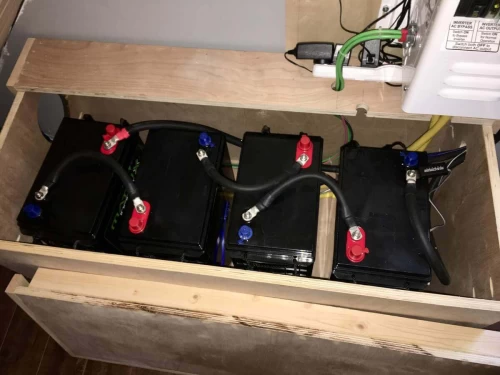
Inverters
An inverter plays a pivotal role in a solar system by converting the direct current (DC) electricity generated by solar panels into alternating current (AC) electricity, which is the type of power used in most household appliances and electronics. This transformation is essential because solar panels produce DC electricity, while homes and businesses primarily run on AC power from the grid.
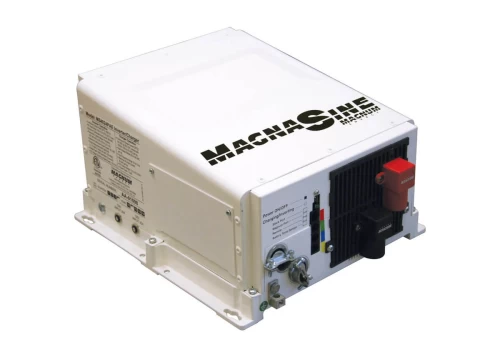
The inverter ensures that the electricity produced by the solar panels is compatible with the electrical needs of your building. It not only converts the type of current but also regulates the voltage and frequency of the AC output to match the standards of the local power grid. This synchronization allows the solar-generated electricity to seamlessly supplement or replace the electricity drawn from the grid, depending on the demand.
We have a very robust and powerful inverter known as an inverter/charger. Our Magnum Energy MS4024PAE 4000W Pure Sine Inverter/Charger 24 Volt allows us to charge the batteries using not only the solar panels but at the flip of a switch charge the batteries using a stand-by generator. Additionally we can charge the batteries while also powering the entire cabin. Lastly, this particular inverter can output 240 volts. Meaning “if ” we ever decided we could actually power something as large as an electric dryer, stove or charge our Model Y Tesla. Currently we charge the Tesla using our level 1 mobile charger.
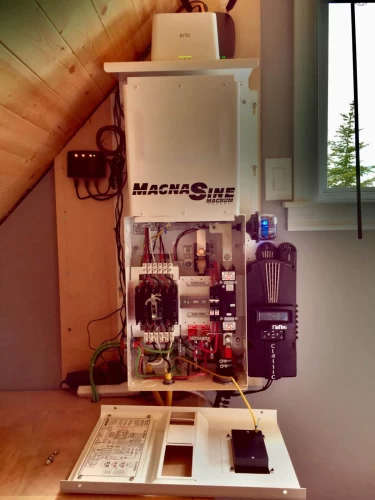
Backup Generators
Some off-grid systems include backup generators fueled by propane, diesel, or other sources. These generators provide electricity during extended periods of low sunlight or high energy demand. We have two portable backup generators we use based on the situation. One 4500 watt Champion we use mainly to charge the batteries and power the cabin during some winter days when the solar panels are covered, the batteries are at a low state of charge (SOC) and we also want to charge the Tesla. The other is a smaller Generac 3000 watt generator. I use that mainly to power tools to save the solar system batteries for cabin internals only. I do have an extension cord that is run from an exterior cabin outlet to the small garage where I keep the ATV on a trickle charger.
In conclusion, off-grid solar systems offer a pathway to energy independence and sustainable living. They redefine the way we think about electricity, empowering us to take control of our energy sources and reduce our impact on the environment. As technology advances and solar energy becomes more accessible, off-grid systems are poised to play a crucial role in shaping a greener and more self-sufficient future.
You might want to check out how we saved $20,000 when buying our off grid property “Cheap off grid land for half price”
DISCLAIMER: We’re not off grid house building experts. We’re off grid house building enthusiasts. the info we share may be different in your neck of the woods to always DYOR when it comes to the rules and regulations in your area(s).
2 Advantages of Off-Grid Solar Systems
Off-grid solar systems offer a range of advantages that make them appealing to those seeking self-sufficiency and sustainable living
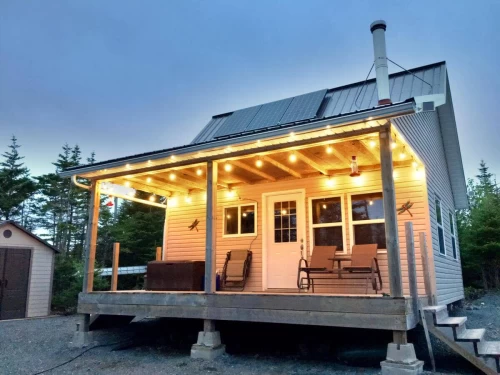
Energy Independence: Off-grid systems free you from reliance on traditional power grids, allowing you to generate your own electricity from renewable sources like solar energy. This autonomy provides resilience against power outages and grid failures.
Remote Living: Off-grid systems enable you to live in remote or rural areas without access to utility services. This empowers individuals to establish homes, cabins, or facilities in locations far from centralized infrastructure.
Reduced Utility Bills: By generating your own power, you can significantly reduce or eliminate monthly utility bills. This can lead to long-term cost savings, making off-grid systems financially beneficial over time.
Environmental Impact: Off-grid systems rely on clean and renewable energy sources, reducing reliance on fossil fuels and minimizing your carbon footprint. This choice aligns with eco-friendly practices and contributes to a greener planet.
Energy Efficiency: Off-grid systems encourage energy conservation and efficiency due to limited energy availability. This often leads to mindful energy consumption and lifestyle adjustments that promote sustainability.
Customization: Off-grid systems can be tailored to your specific energy needs and location. You can size the system according to your electricity demands, ensuring that it suits your lifestyle and requirements.
Resilience and Security: Off-grid systems offer energy security in situations where grid power might be unavailable or unreliable, such as during natural disasters. This resilience enhances your ability to weather unexpected challenges. We used to use an arlo security system but recently switched to a fully solar powered wireless system from Eufy called the Eufy Security Outdoor SoloCam S230(S40).
Incentives and Rebates: In some regions, government incentives and rebates are available to support the adoption of off-grid solar systems, making the initial investment more affordable. Canadian solar incentives. US solar incentives.
Educational Value: Managing an off-grid system encourages learning about energy production, storage, and consumption. It can provide valuable insights into sustainable living and self-sufficiency practices.
Long-Term Investment: Off-grid systems have the potential to pay for themselves over time through reduced utility costs, making them a wise long-term investment.
It’s important to note that while off-grid systems offer these advantages, they also come with considerations such as system design, maintenance, and upfront costs. Assessing your energy needs, location, and budget will help you determine if an off-grid solar system is the right fit for your lifestyle and goals.
3 Designing Your Off-Grid System
We will go into much greater depth if the details involved with designing a solar system specific to your needs and geographic location in future posts but here is a high level brief overview of the steps involved. We went with a completely pre wired solar system. The only work we needed to do was install the panels, run the wires into the charge controller and wire up the batteries. I had already wired the cabin my self and installed a power distribution panel to the output AC power from the inverter simply ran directly into the power distribution panel.
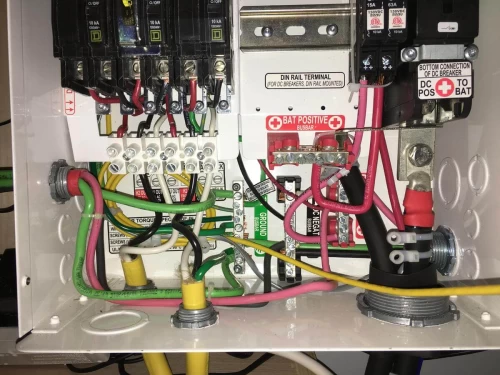
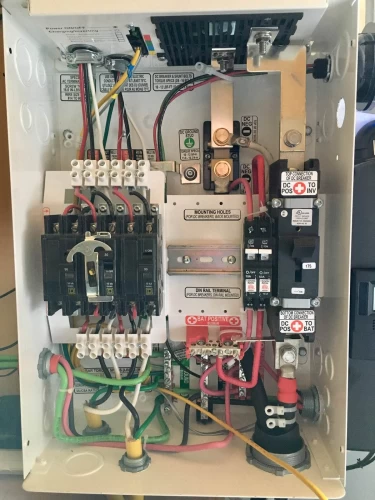
Having all of this wiring done by ahead of time saved us a lot of work.
If you’re looking for a complete off-grid system that’s been custom engineered and designed so that all the components work in harmony check out Solar Power Store and look at their completely done for you solar system.
Energy Assessment: Calculate your daily energy consumption by listing all appliances and devices you intend to power. Determine their power ratings (in watts) and the average hours of usage per day. There are online calculators that make this simple and enlightening. We’ll share some of those below.
Location Analysis: Consider your location’s solar resource potential. Assess factors like average sunlight hours, shading from trees or buildings, and seasonal variations in solar exposure. Here in Nova Scotia we have some of the best locations for off grid solar.
System Sizing: Based on your energy assessment and location analysis, size your solar panel array to produce enough energy to meet your daily needs. Choose an appropriate battery capacity to store excess energy for use during cloudy days or at night.
Battery Sizing: Determine the battery bank’s capacity, measured in kilowatt-hours (kWh), to store energy for times when the sun isn’t shining. Consider factors like your desired autonomy (number of days of energy independence), battery efficiency, and depth of discharge.
Inverter Sizing: Select an inverter capable of handling the peak load demand of your appliances and devices. Ensure that it’s compatible with your battery bank’s voltage and type.
Charge Controller Selection: Choose a charge controller that matches the voltage of your solar panel array and battery bank. Consider an MPPT controller for increased efficiency, especially in larger systems.
Wiring and Safety: Design the wiring layout to connect solar panels, batteries, charge controller, and inverter. Ensure proper fusing, grounding, and safety measures to prevent overloads and electrical hazards.
This is a great post by Tiny Shiny Home with a full diagram of how their solar system is wired…
Mounting and Installation: Plan the placement and orientation of solar panels for optimal sun exposure. Install panels securely and efficiently, following manufacturer guidelines and safety protocols. Here is a great solar panel tilt angle calculator from FootPrintHero.
Monitoring and Maintenance: Incorporate a monitoring system to track energy production, battery status, and system performance. Regular maintenance, including cleaning panels and checking battery health, ensures long-term efficiency.
Backup Generation (Optional): If desired, include a backup generator powered by fuel (e.g., propane, diesel) to provide energy during extended periods of low sunlight or high demand.
System Integration: Ensure that all components work seamlessly together by wiring and configuring them correctly. Test the system thoroughly to identify and address any issues.
Regulations and Permits: Check local regulations and obtain necessary permits before installation. Compliance with safety standards and local codes is crucial for a safe and legally compliant system.
Professional Consultation: Consider consulting with a solar professional or an engineer to optimize your system design, especially for larger or complex installations. Consider following our route of having your solar system supplier prewire your system. There are several options like the one we used available.
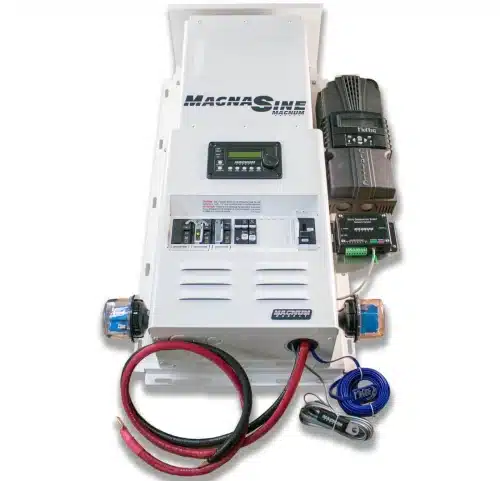
Designing your off-grid solar system is a collaborative process that involves assessing your energy needs, understanding the technical components, and aligning them with the conditions of your location. Careful planning and attention to detail will ensure that your system provides reliable, sustainable energy for years to come.
Not only did we design our cabin and determine our solar system requirements but we built our off grid cabin in just two weeks. Orientation of the cabin played a major role as we knew we wanted to have a southern facing roof and a roof pitch of 45 degrees. Here’s how we managed to build everything in two weeks…
- clearing the land
- carrying all the building materials to the build site by hand
- building the foundation
- framing the cabin and the roof
- installing all the doors and windows
- putting up all the exterior/roof sheathing
4 Installation and Maintenance
The installation process of an off-grid solar system involves several key steps. It begins with site assessment and planning, evaluating solar resource potential and determining optimal panel placement. Solar panels are then mounted securely on rooftops or other suitable surfaces, and wiring is routed to a combiner box. The charge controller is installed, regulating solar energy flow to the battery bank. Batteries are set up, connected to store energy, and the inverter is installed to convert DC energy into AC power for household use. AC load connections link the inverter to the electrical panel, and a transfer switch may be added for grid interaction. The system is tested, configurations adjusted, and safety checks performed. Proper grounding, system monitoring, and maintenance routines ensure a successful and reliable off-grid solar installation.
Installing a Solar System: General Process
- Site Assessment and Planning: Evaluate your location’s solar resource potential, considering factors like shading, orientation, and sun exposure. Determine the optimal placement and angle for mounting solar panels.
- Solar Panel Installation: Mount solar panels securely on rooftops, ground mounts, or other suitable surfaces. Connect panels in series or parallel to achieve the desired voltage and current for your system.
- Wiring and Combiner Box: Route wiring from the panels to a combiner box, which consolidates the connections. Install appropriate fuses and disconnect switches for safety.
- Charge Controller Installation: Mount the charge controller in a cool, well-ventilated location. Connect the solar panel array to the charge controller, ensuring correct polarity and voltage matching.
- Battery Bank Installation: Set up the battery bank in a clean, dry, and well-ventilated area. Connect the batteries in series or parallel to achieve the desired voltage and capacity.
- Inverter Installation: Choose an appropriate location for the inverter, considering factors like ventilation and accessibility. Connect the inverter to the battery bank, adhering to proper polarity and sizing requirements.
- AC Load Connection: Wire the inverter’s AC output to your household’s electrical distribution panel. Install a transfer switch to switch between grid power and your off-grid system, if needed.
- System Testing and Commissioning: Test all connections and components to ensure they’re properly wired and functioning. Verify that the solar panels are generating electricity and charging the batteries.
- System Configuration and Monitoring: Configure the charge controller and inverter settings according to your system specifications. Set up a monitoring system to track energy production, battery status, and system performance.
- Safety Checks and Maintenance: Conduct safety checks to ensure proper grounding and protection against electrical hazards. Implement a maintenance routine to clean solar panels, inspect batteries, and monitor overall system health.
- System Optimization: Monitor system performance over time and make adjustments as needed to maximize energy production and efficiency. Consider fine-tuning settings to optimize battery charging and system operation.
- Education and Training: Educate yourself and household members about the system’s operation, maintenance, and safety procedures. Provide guidance on energy management to ensure efficient usage.
- Remember that every off-grid solar installation is unique, and the specific steps may vary based on the components you’re using and your location. It’s essential to follow manufacturer instructions, local regulations, and best practices to ensure a successful and safe off-grid solar setup.
Solar System Maintenance
System maintenance is essential to ensure the consistent performance and longevity of an off-grid solar system. Regular visual inspections, including checking connections, wiring, and mounting structures, help identify any damage or wear. Cleaning solar panels from dust, debris and snow helps optimize energy production. Monitoring battery voltage, charge status, and electrolyte levels, if applicable, ensures proper battery health. Calibrating charge controller settings and conducting seasonal adjustments enhance overall efficiency. Scheduled professional inspections, generator tests, and knowing how your system functions all contribute to a well-maintained and most importantly reliable off-grid solar system.
5 Off-Grid Living Considerations
Living off-grid using solar power entails a range of considerations. It requires embracing energy efficiency, adapting to daily energy limitations, and being mindful of energy-intensive activities.

While we can and do charge our Tesla using solar in a pinch, it’s much easier and less of a headache to simply charge the car when we are in town. Oftentimes free at any of the hundreds of locations in our city that provide free charging while you shop.
Maintaining and monitoring the solar system becomes essential, as does understanding weather patterns and seasonal changes that affect energy generation. Lifestyle adjustments, from managing power during cloudy days to using appliances strategically, play a key role. Prioritizing sustainable practices, minimizing energy consumption, and fostering a connection with nature are integral to a successful and rewarding off-grid solar-powered lifestyle. Learn the limits of your solar system early in your ownership and prevent situations where you run out of power when you really, REALLY need it.
Conclusion
In conclusion, the journey towards off-grid solar has become much easier, accessible and affordable over the past few years. With the advancement of battery storage technology, electronics and solar panel technology a properly maintained solar system can function optimally for decades. By embracing off-grid living powered by solar energy, individuals and communities can rewrite their energy narratives, achieving resilience, autonomy, and a greener footprint. With careful planning, thoughtful consideration of system components, and a commitment to responsible energy consumption, the road to off-grid success becomes a beacon of hope for a more sustainable and harmonious future. We hope this post has shed a bit of light on the idea of living solely using solar. It’s not only satisfying to know your home is run from sunlight but that you can helping create a better future for the entire planet.
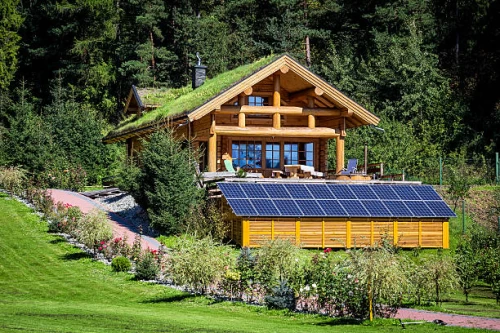
Be sure to poke around the site for more informative off grid living info including the complete build of our off grid cabin.
Additional Solar Resources:
Canadian Sites…
Canadian Off grid Solar Depot Off Grid Solar Packages
SRB Energy Canada Solar Resources Page
Off the Grid Solar Energy Solutions
Solar Power Store Solar Power Kits
US Sites…
Unbound Solar Off Grid Solar Systems
Your Turn...
P.S. If you enjoyed this post about Harnessing the Sun: A Beginner’s Guide to Off-Grid Solar Systems then why not share it.
Share This Story, Choose Your Platform!
It’s how we keep growing our off grid community here and lets us know we’re posting the right kind of info you’re looking for.
Here’s a special Pinterest PIN for all our Pinterest fans out there!
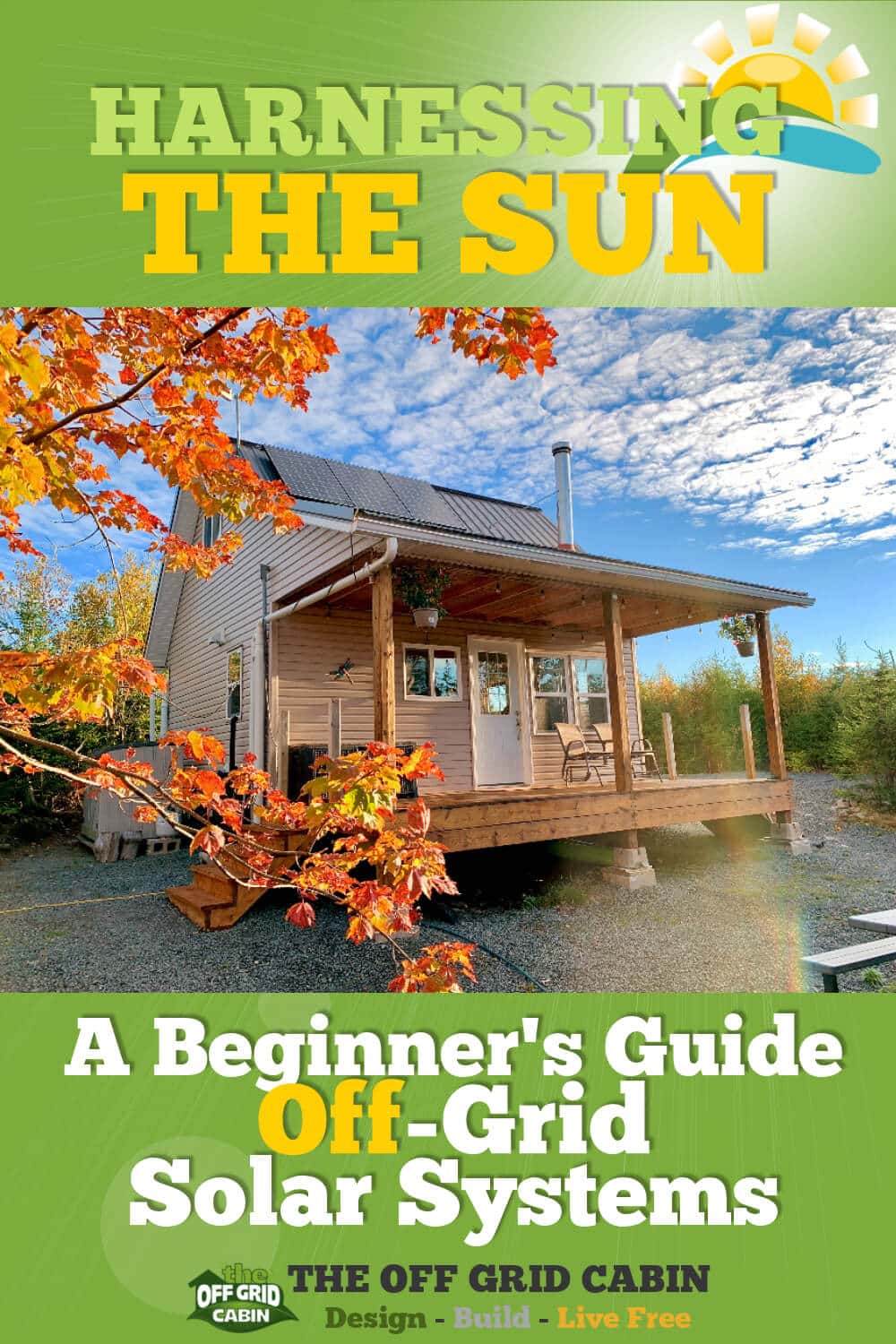
Let us know what you think in the comment section below.
And be sure to join the rest of the off grid community here and follow along with the build of our cabin!
We’ll update the Building The Cabin section every time we complete a new phase of the build so be sure to check in and watch the progression.
how to clean solar panels
How to Clean Solar Panels: A Step-by-Step DIY Guide As you already know, residential and off-grid solar systems are amazing sources of renewable energy that are quickly growing in popularity. The large flat [...]
earthship
What Is an Earthship and How It Can Help Save the Planet Imagine living in a home that is completely self-sufficient, eco-friendly, and comfortable. A home that grows its own food, collects its [...]
3-way-switch-wiring
3-Way Switch Wiring: A How to Comprehensive Guide Here at the off grid cabin we’ve done our fair share of electrical work including 3-way switch wiring. We’ve done all the internal and external [...]
solar generator
How To Find The Best Solar Generator Impact-Site-Verification: c336f89e-c692-4afd-99d9-0150f7329466 When we first cleared the land to build our off grid home back in 2016, we started with one of those small 700 watt [...]
Off Grid Heating
The Best Off Grid Heating Methods Introduction To Off Grid Heating If you're Living off the grid already or planning to in the future, you already know how important it is to have [...]
off grid appliances
The Best Off Grid Appliances for Off Grid Living Introduction To Off Grid Appliances Living off the grid can be a rewarding and fulfilling experience, but it also comes with some challenges. One [...]


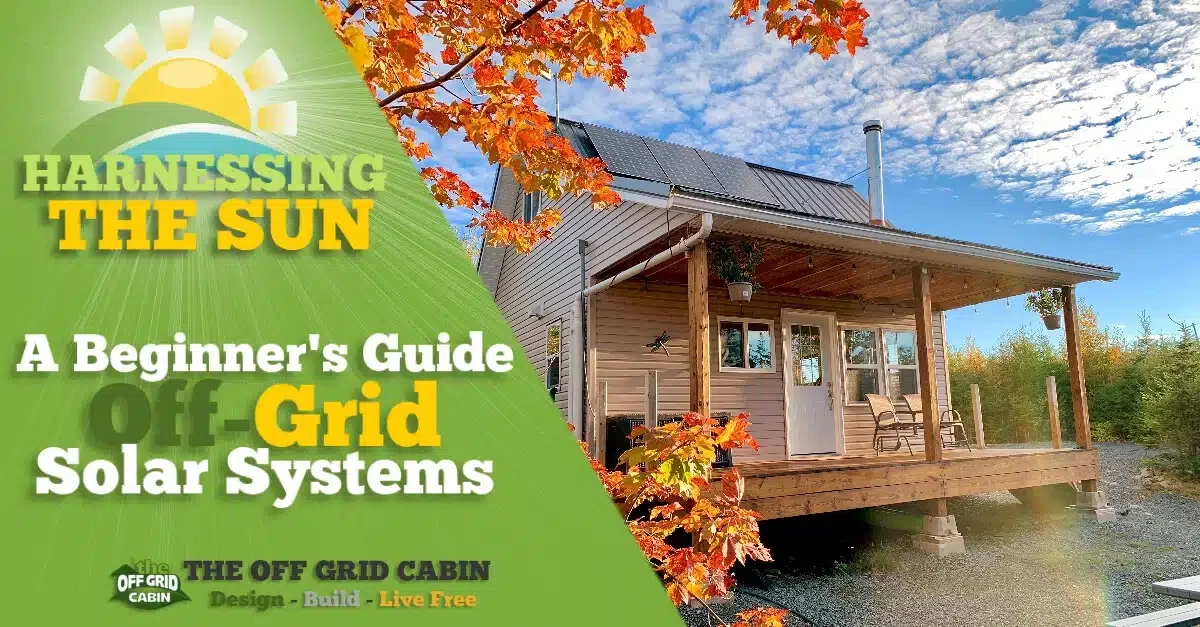

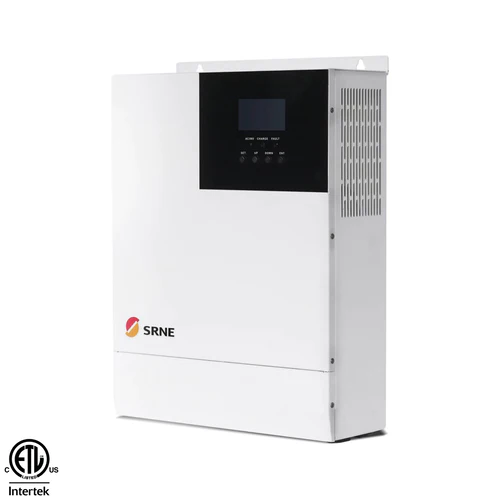
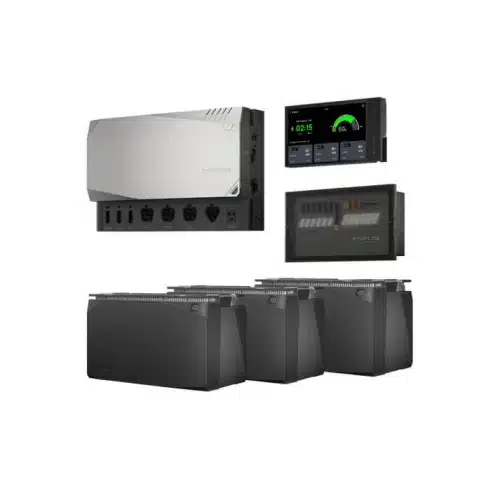
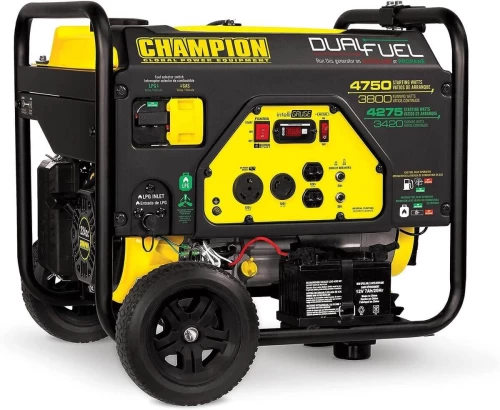
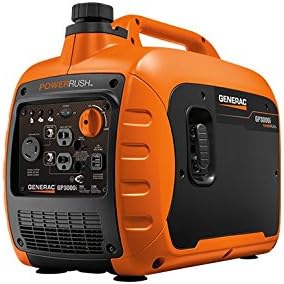
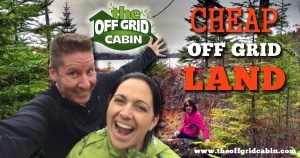
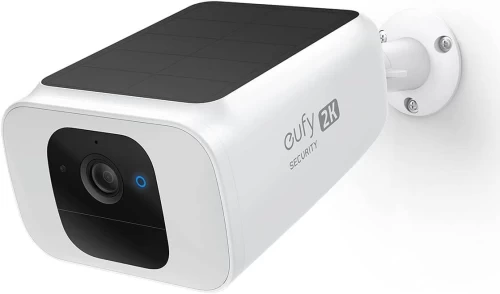
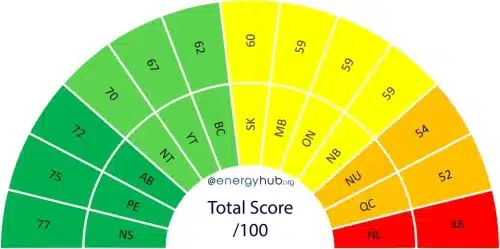
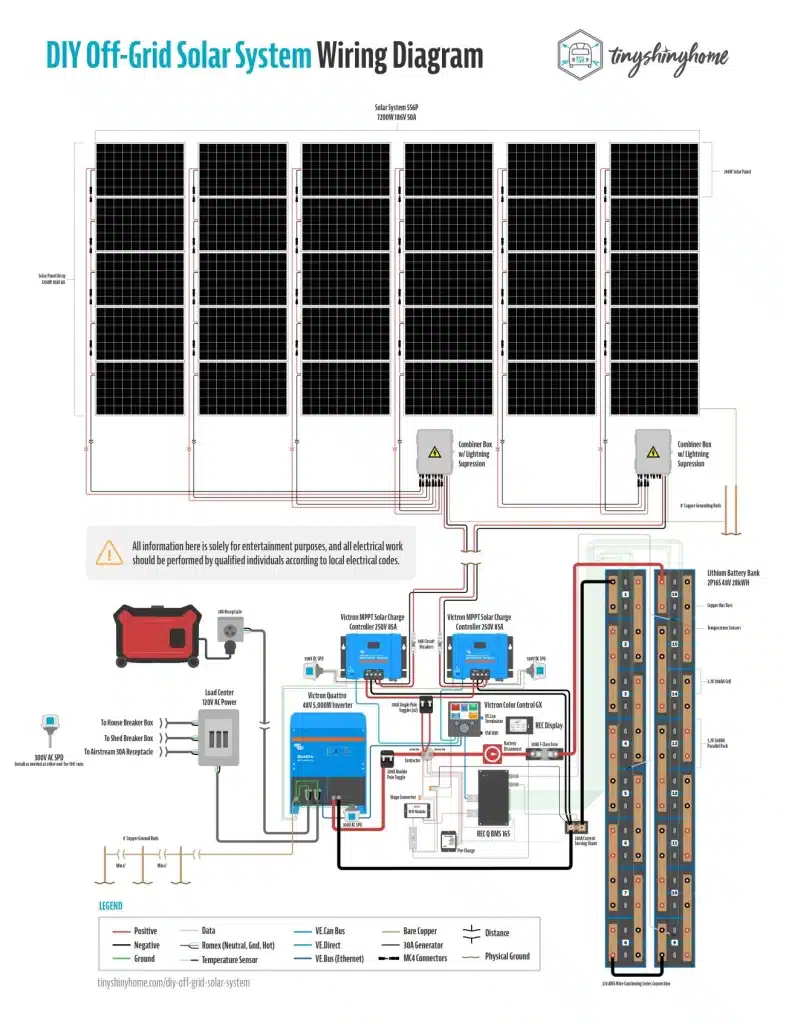
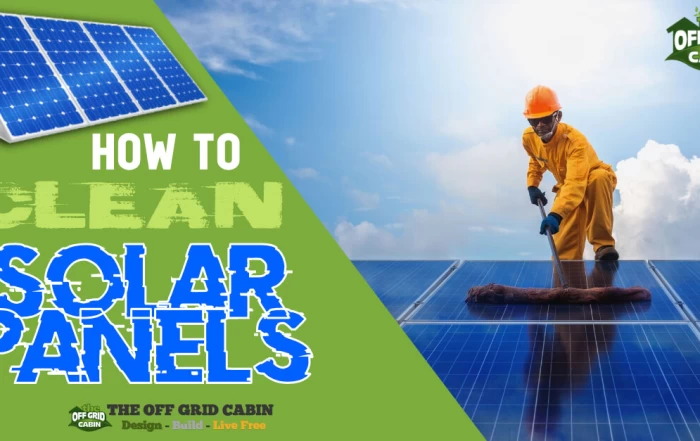
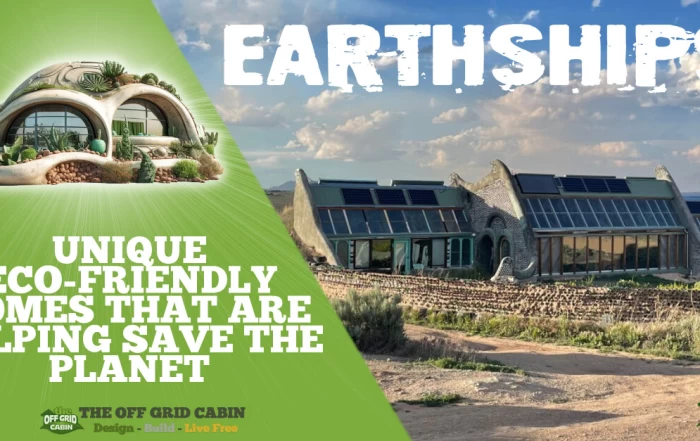

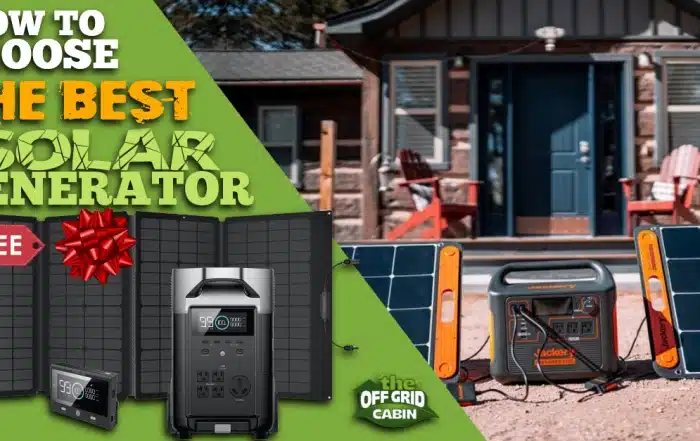


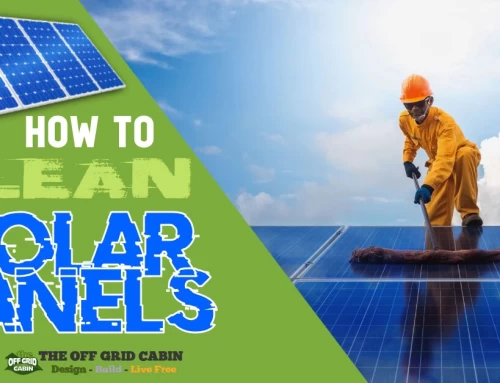
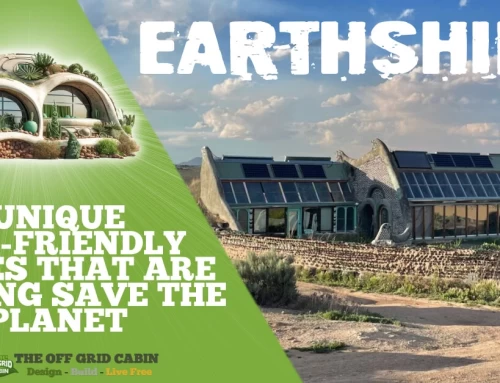

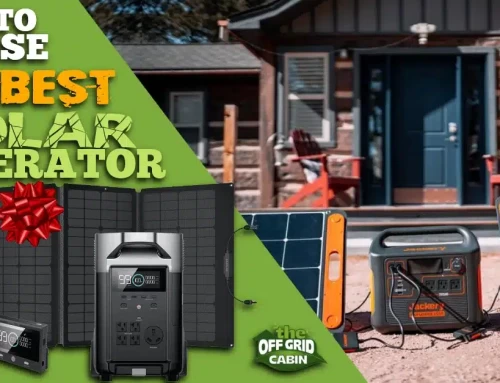


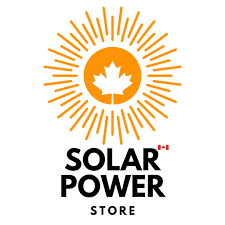


Leave A Comment